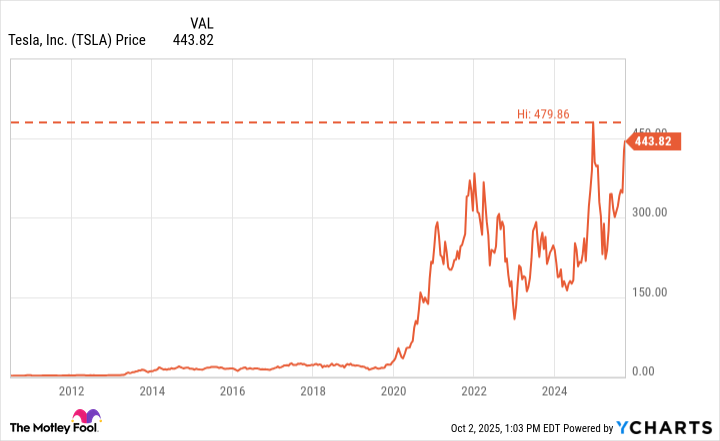For years, federal subsidies have played a critical role in accelerating the adoption of electric vehicles (EV). Most notably, President Joe Biden's Inflation Reduction Act included a $7,500 tax credit designed to make EV purchases more affordable and spur demand. Under President Donald Trump, however, policy priorities have shifted. As part of the newly enacted "big, beautiful bill," the EV tax credit was eliminated as of Sept. 30.
Let's examine how this policy change could affect Tesla (TSLA 3.53%) and what it could mean for the company's trajectory going forward.

Image source: Tesla.
Spoiler alert: Tesla crushed Q3 deliveries
Shortly after the legislation was signed into law, I predicted that eliminating the EV tax credit would actually provide Tesla with a short-term boost. The logic was straightforward: Consumers who had been undecided about purchasing an EV would likely accelerate their decisions in order to take advantage of the $7,500 credit before it expired.
According to consensus estimates from FactSet and Bloomberg, Wall Street expected Tesla's third quarter vehicle deliveries to fall in the range of 439,800 to 447,600 units. In reality, Tesla delivered 497,099 cars during the quarter -- absolutely shattering analyst expectations.
In short, the removal of the EV tax credit was far from a death knell for Tesla. Relying solely on subsidies to determine the health of Tesla's business and its future roadmap is a narrow view of the company's potential. As the discussion below will show, Tesla's long-term investment case extends well beyond government incentives.
Tesla's expanding vision: More than just cars
Investing in Tesla requires shareholders to be fully aligned with Elon Musk's broader technological ambitions. At its core, Musk's vision for Tesla is centered on artificial intelligence (AI), robotics, and autonomous systems.
Consider Optimus, Tesla's humanoid robot project. While still in early development, Optimus is designed as a scalable, general-purpose robot with the potential to augment human labor within factories -- boosting productivity and delivering exponential cost savings over time. In fact, Musk himself has touted that Optimus could represent 80% of Tesla's future value once scaled.
Equally transformative is Tesla's vision to create a robotaxi network. The company aims to deploy a fleet of fully autonomous vehicles capable of generating recurring revenue streams that far exceed the economics of one-time vehicle sales. If successful, robotaxi could not only disrupt incumbents in the mobility market -- such as Lyft, Uber Technologies, DoorDash, or Hertz -- but it could also unlock a new business model for Tesla: A software-driven, high-margin service powered by its Full Self-Driving (FSD) platform.
On a deeper level, Tesla's potential extends beyond physical products and into the intangible realm of machine intelligence. Musk has repeatedly hinted at closer integration between Tesla and his separate venture, xAI -- which is developing a large language model (LLM) known as Grok to compete with OpenAI. Such a partnership could meaningfully enhance Tesla's software stack, enabling a more intelligent and connected ecosystem that spans vehicles, robots, and AI-powered services.
Is Tesla stock a buy now?
The loss of the $7,500 EV subsidy may affect short-term affordability for certain buyer segments, but ultimately it does not fundamentally change Tesla's long-term investment thesis.
That said, valuation deserves careful attention. As of Oct. 2, Tesla shares were trading near all-time highs. Recent momentum has been fueled in part by Musk's $1 billion open-market purchase of Tesla stock, as well as traders positioning ahead of the Q3 delivery beat -- which indeed materialized.
For these reasons, I would be cautious about chasing Tesla at current levels. While projects like Optimus, the robotaxi network, and potential xAI synergies are exciting, none have yet generated material revenue or profit. Each remains highly speculative at this stage.
For now, investors may be better served monitoring Tesla's execution on the AI front and considering entry points on pullbacks rather than buying into the stock at peak optimism.






